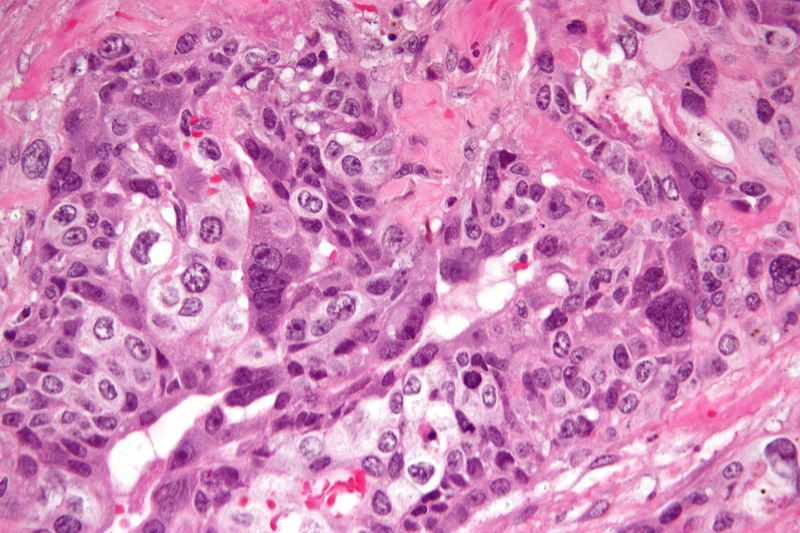Gestational trophoblastic neoplasia pathophysiology: Difference between revisions
No edit summary |
|||
| Line 20: | Line 20: | ||
#*Typically multinucleated. | #*Typically multinucleated. | ||
===Video=== | |||
{{#ev:youtube|X6PZ0nRM554}} | |||
Traditionally, the syncytiotrophoblasts are said to produce the beta-hCG;<ref name=pmid20735820>{{Cite journal | last1 = Cole | first1 = LA. | title = Biological functions of hCG and hCG-related molecules. | journal = Reprod Biol Endocrinol | volume = 8 | issue = | pages = 102 | month = | year = 2010 | doi = 10.1186/1477-7827-8-102 | PMID = 20735820 | PMC = 2936313 | URL = http://www.ncbi.nlm.nih.gov/pmc/articles/PMC2936313/ }}</ref>however, it has been determined that cytotrophoblast also produce some.<ref name=pmid12242037>{{Cite journal | last1 = Kovalevskaya | first1 = G. | last2 = Genbacev | first2 = O. | last3 = Fisher | first3 = SJ. | last4 = Caceres | first4 = E. | last5 = O'Connor | first5 = JF. | title = Trophoblast origin of hCG isoforms: cytotrophoblasts are the primary source of choriocarcinoma-like hCG. | journal = Mol Cell Endocrinol | volume = 194 | issue = 1-2 | pages = 147-55 | month = Aug | year = 2002 | doi = | PMID = 12242037 }}</ref>The syncytiotrophoblasts are often arranged around the outside of cytotrophoblast cell clusters, reminicent of the arrangement in the [[w:placenta|placenta]]. On placental [[w:Chorionic_villi|villi]], the syncytiotrophoblasts are superficial to and, early in [[w:pregnancy|pregnancy]], cover the cytotrophoblast.Choriocarcinoma is classified as a [[w:germ cell tumour|germ cell tumour]]. It can arise in the [[w:testis|testis]] or [[w:ovary|ovary]] and from a [[w:hydatidiform mole|hydatidiform mole]]. It may be part of a [[w:mixed germ cell tumour|mixed germ cell tumour]]. | Traditionally, the syncytiotrophoblasts are said to produce the beta-hCG;<ref name=pmid20735820>{{Cite journal | last1 = Cole | first1 = LA. | title = Biological functions of hCG and hCG-related molecules. | journal = Reprod Biol Endocrinol | volume = 8 | issue = | pages = 102 | month = | year = 2010 | doi = 10.1186/1477-7827-8-102 | PMID = 20735820 | PMC = 2936313 | URL = http://www.ncbi.nlm.nih.gov/pmc/articles/PMC2936313/ }}</ref>however, it has been determined that cytotrophoblast also produce some.<ref name=pmid12242037>{{Cite journal | last1 = Kovalevskaya | first1 = G. | last2 = Genbacev | first2 = O. | last3 = Fisher | first3 = SJ. | last4 = Caceres | first4 = E. | last5 = O'Connor | first5 = JF. | title = Trophoblast origin of hCG isoforms: cytotrophoblasts are the primary source of choriocarcinoma-like hCG. | journal = Mol Cell Endocrinol | volume = 194 | issue = 1-2 | pages = 147-55 | month = Aug | year = 2002 | doi = | PMID = 12242037 }}</ref>The syncytiotrophoblasts are often arranged around the outside of cytotrophoblast cell clusters, reminicent of the arrangement in the [[w:placenta|placenta]]. On placental [[w:Chorionic_villi|villi]], the syncytiotrophoblasts are superficial to and, early in [[w:pregnancy|pregnancy]], cover the cytotrophoblast.Choriocarcinoma is classified as a [[w:germ cell tumour|germ cell tumour]]. It can arise in the [[w:testis|testis]] or [[w:ovary|ovary]] and from a [[w:hydatidiform mole|hydatidiform mole]]. It may be part of a [[w:mixed germ cell tumour|mixed germ cell tumour]]. | ||
Revision as of 13:51, 18 March 2013
Template:Choriocarcinoma Editor-In-Chief: C. Michael Gibson, M.S., M.D. [1];Associate Editor(s)-in-Chief: Shivali Marketkar, M.B.B.S. [2]
Please help WikiDoc by adding more content here. It's easy! Click here to learn about editing.
Pathophysiology
Microscopic Pathology
On light microscopy, there is malignant trophoblastic proliferation without hydropic villi.Characteristic feature is the identification of intimately related syncytiotrophoblasts and cytotrophoblasts without formation of definite placental type villi.Syncytiotrophoblasts are large multi-nucleated cells with eosinophilic cytoplasm. They often surround the cytotrophoblasts, reminiscent of their normal anatomical relationship in chorionic villi. Cytotrophoblasts are polyhedral, mononuclear cells with hyperchromatic nuclei and a clear or pale cytoplasm. Extensive hemorrhage is a common finding.Shown below is an image of choriocarcinoma.(High mag|H&E stain)
The Image shows:
Choriocarcinomas consist of two cell populations:
- Cytotrophoblasts.
- Pale/clear cytoplasm.
- Syncytiotrophoblasts.
- Hyperchromatic cytoplasm.
- Typically multinucleated.
Video
{{#ev:youtube|X6PZ0nRM554}} Traditionally, the syncytiotrophoblasts are said to produce the beta-hCG;[1]however, it has been determined that cytotrophoblast also produce some.[2]The syncytiotrophoblasts are often arranged around the outside of cytotrophoblast cell clusters, reminicent of the arrangement in the placenta. On placental villi, the syncytiotrophoblasts are superficial to and, early in pregnancy, cover the cytotrophoblast.Choriocarcinoma is classified as a germ cell tumour. It can arise in the testis or ovary and from a hydatidiform mole. It may be part of a mixed germ cell tumour.
References
- ↑ Cole, LA. (2010). "Biological functions of hCG and hCG-related molecules". Reprod Biol Endocrinol. 8: 102. doi:10.1186/1477-7827-8-102. PMC 2936313. PMID 20735820.
- ↑ Kovalevskaya, G.; Genbacev, O.; Fisher, SJ.; Caceres, E.; O'Connor, JF. (2002). "Trophoblast origin of hCG isoforms: cytotrophoblasts are the primary source of choriocarcinoma-like hCG". Mol Cell Endocrinol. 194 (1–2): 147–55. PMID 12242037. Unknown parameter
|month=ignored (help)
